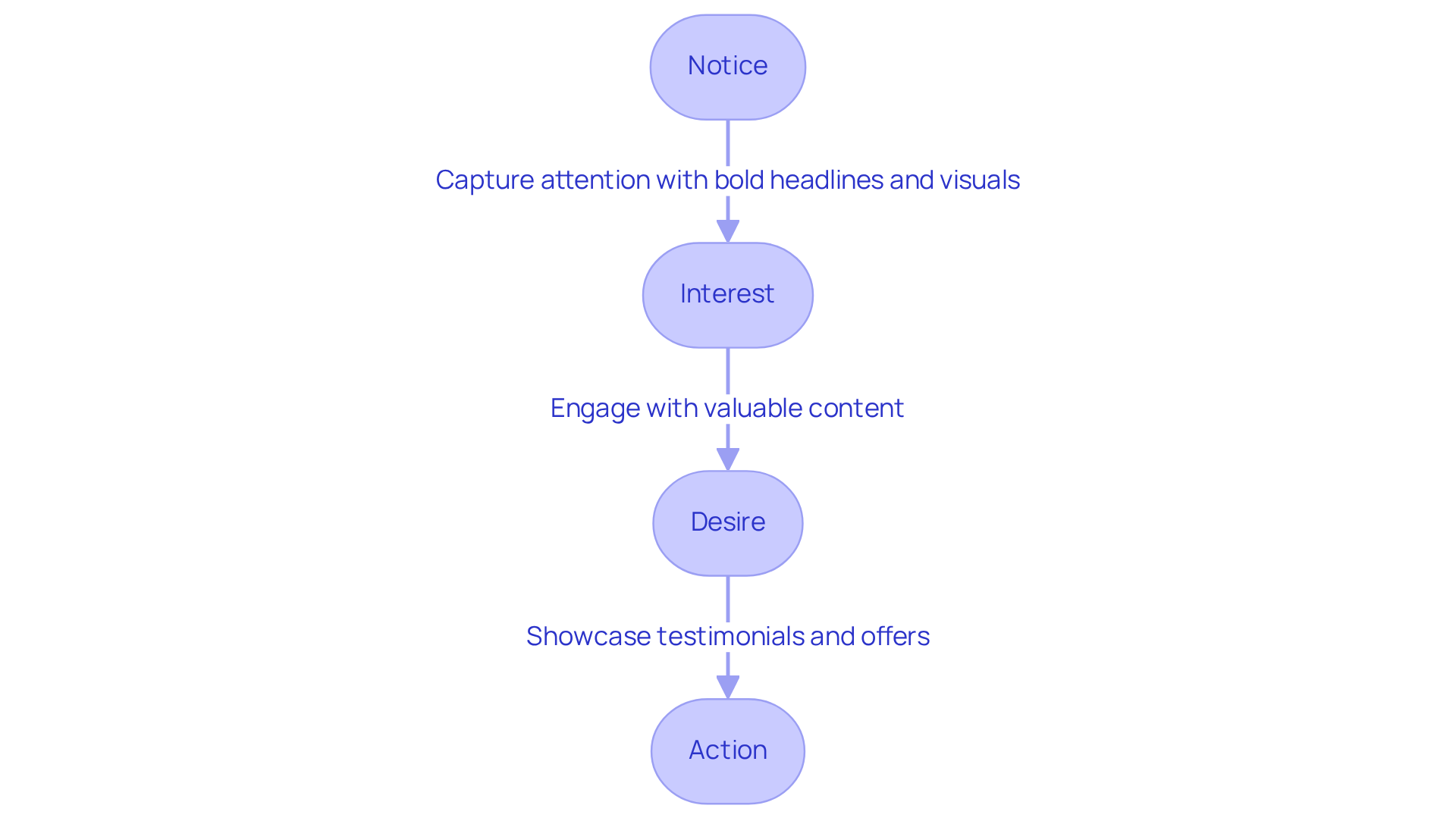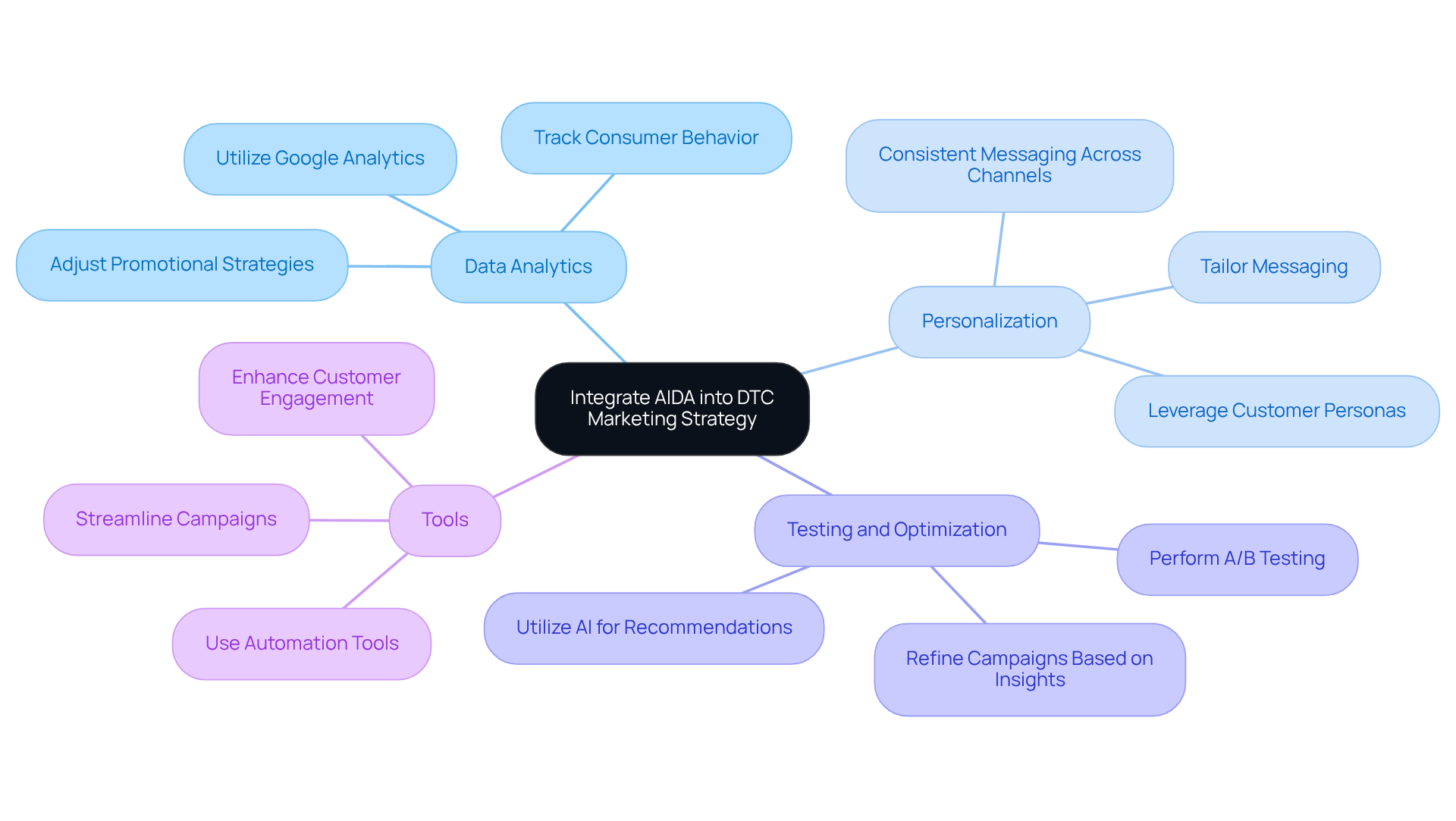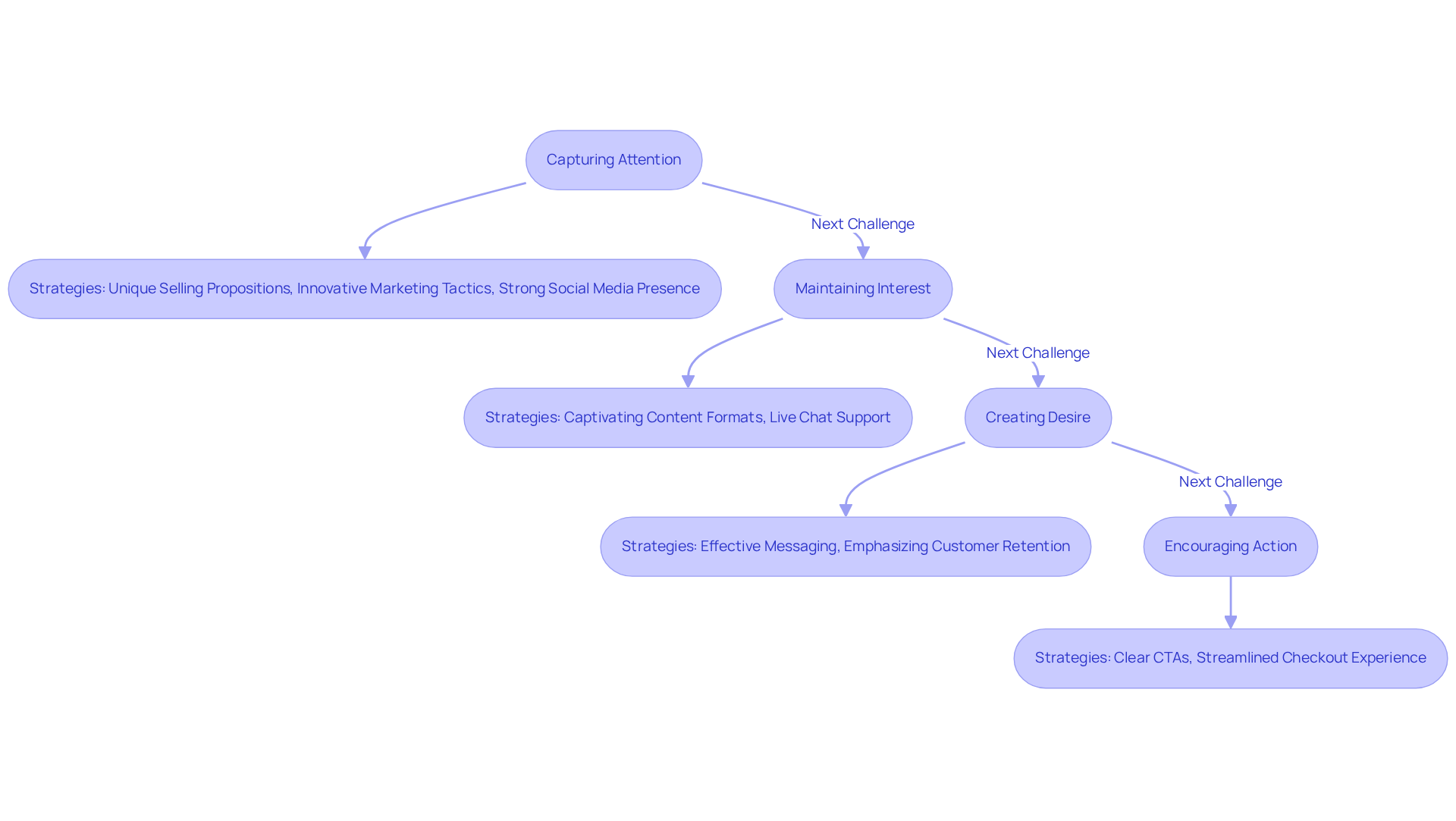
Overview
The AIDA method stands as a cornerstone of effective direct-to-consumer (DTC) marketing strategies, guiding marketers through the critical stages of:
- Capturing attention
- Fostering interest
- Creating desire
- Prompting action
By harnessing the power of data analytics, personalization, and clear calls-to-action, brands can significantly enhance consumer engagement and drive conversion rates. This underscores the model's relevance in today’s fiercely competitive marketplace, where understanding consumer behavior is paramount. Brands that master the AIDA framework not only position themselves for success but also cultivate deeper connections with their audience, ultimately leading to sustained growth and loyalty.
Introduction
The AIDA method serves as a cornerstone of effective marketing, delineating the journey consumers embark upon from awareness to action. Mastering this framework empowers brands to significantly enhance their direct-to-consumer (DTC) strategies, resulting in improved engagement and conversion rates.
However, as the marketing landscape evolves with the advent of AI and hyper-personalization, brands face the challenge of navigating the complexities of the AIDA model. The question arises: how can they not only capture attention but also sustain interest and drive action?
Understand the AIDA Model: Key Components and Purpose
The stands as a foundational marketing framework that delineates the stages an individual navigates before making a purchase. Each component is crucial in shaping :
- Attention: The initial phase centers on capturing the consumer's attention through striking advertisements, compelling content, or distinctive selling propositions. Techniques such as curiosity-driven headlines and visual hooks prove effective in this stage.
- Interest: Following the acquisition of attention, the next step involves fostering interest by providing relevant information that aligns with the individual's needs or aspirations. This may encompass showcasing product features or benefits that resonate with the target audience.
- Desire: At this juncture, the objective shifts to forging a strong , compelling the individual to desire the product or service. Strategies such as storytelling, user testimonials, and highlighting unique benefits can effectively create this emotional bond. For instance, illustrating how products solve specific problems can enhance this connection.
- Action: The framework culminates in motivating the buyer to take decisive steps, whether that entails making a purchase or subscribing to a newsletter. Here, (CTAs) play a pivotal role, simplifying the decision-making process and minimizing friction. Employing value-forward CTAs and streamlining sign-up processes are recommended tactics to enhance this phase.
Understanding these elements is essential for based on the AIDA method that resonate with audiences and . As we approach 2025, the significance of this framework remains paramount, particularly as brands increasingly leverage AI and hyper-personalization to refine every phase of the consumer journey, ultimately resulting in improved engagement and heightened conversion rates. Notably, firms employing AI-enhanced personalization in their processes can witness up to a 20% increase in ROI, underscoring the method's ongoing relevance in contemporary advertising.

Apply the AIDA Steps: Attention, Interest, Desire, Action
To effectively apply the in today's marketing landscape, follow these steps:
- Notice: Capture audience interest with bold headlines, striking visuals, or thought-provoking questions. For instance, a DTC brand might leverage vibrant social media posts that highlight unique product features, effectively standing out in a crowded digital landscape.
- Interest: Once attention is secured, engage audiences with valuable content that addresses their pain points. This can be achieved through blog posts, videos, or infographics that clearly demonstrate how your product resolves specific issues, fostering a deeper connection with potential customers.
- Desire: Cultivate desire by showcasing testimonials, case studies, or limited-time offers. For example, sharing customer success stories can illustrate the tangible benefits of your product, making it relatable and appealing. This strategy not only enhances but also builds trust. As Sergey Kovalev highlights, employing emotional triggers at every phase of the model can create stronger bonds with your clients.
- Action: Conclude with (CTAs). Phrases like "Shop Now" or "Get Yours Today" can effectively prompt immediate responses. Additionally, ensuring a seamless purchasing process minimizes friction, significantly .
It is crucial to highlight that although the AIDA method remains pertinent, contemporary variations that include are vital to satisfy changing buyer expectations. Furthermore, addressing is essential for long-term success in today's marketplace. By applying these strategies, brands can improve their promotional effectiveness, as demonstrated by 's success in attaining a 36% rise in ROI on ads for clients, underscoring the strength of the AIDA method.

Integrate AIDA into Your DTC Marketing Strategy: Best Practices and Tools
To effectively integrate the into your , it is essential to consider the following best practices:
- Utilize : Leverage tools like Google Analytics to meticulously track at each stage of the AIDA model. Insights derived from data analytics will guide necessary adjustments to your promotional strategies, ensuring they remain effective and relevant. With an anticipated $34 billion allocated to , comprehending consumer interactions through analytics is crucial for maximizing these investments.
- Personalization: Tailor your messaging to resonate with distinct audience segments. By leveraging customer personas, you can create that directly address the unique needs and preferences of your customers, thereby enhancing engagement and . As Diane Keng, CEO of Breinify, aptly notes, "Shopper beyond just product recommendations into full content experiences." Execute the AIDA method across various platforms, including social media, email outreach, and your website. Consistent messaging across these channels reinforces brand recognition and builds trust with your audience. Successful brands like Brooklinen have demonstrated that maintaining a cohesive omnichannel presence can significantly boost e-commerce sales.
- Testing and Optimization: Regularly perform on your promotional materials to ascertain what resonates most with your audience. Utilize the insights gained to continuously refine your approach, ensuring your campaigns are always aligned with consumer preferences. For instance, Stitch Fix effectively employs AI to provide personalized style recommendations, showcasing the power of .
- Tools: Consider utilizing automation tools such as HubSpot or Mailchimp to streamline your campaigns. These tools can help ensure timely follow-ups with potential customers, thereby enhancing the overall effectiveness of your marketing efforts. By automating these processes, you can concentrate on creating engaging content that drives conversions.
By concentrating on these best practices, DTC brands can efficiently apply the framework, enhancing engagement and significantly boosting conversion rates in a competitive marketplace.

Troubleshoot AIDA Implementation: Overcoming Common Challenges
When implementing the AIDA model, brands may encounter several challenges:
- in a Saturated Market: In a landscape where numerous brands compete for consumer attention, distinguishing oneself becomes a formidable task. To navigate this challenge, prioritize and innovative marketing tactics that set your brand apart. Notably, nearly one in three individuals now turn to social media for product discovery and purchases, underscoring the necessity of a in today’s .
- Maintaining Interest with the : After successfully capturing attention using the AIDA method, the next hurdle is sustaining customer engagement. Employ captivating content formats, such as videos or interactive quizzes, to keep interest alive. Furthermore, customers who utilize live chat when visiting online stores exhibit a 20% higher likelihood of conversion, highlighting as a crucial tool for ongoing engagement.
- Creating Desire: Should potential purchasers lack a strong desire for your product, it is essential to revisit your messaging strategy by applying the AIDA method. Ensure that you effectively communicate the benefits and emotional connections tied to your product. Brands that emphasize customer retention over acquisition are 60% more profitable, illustrating the significance of nurturing robust to foster desire.
- Encouraging Action: If consumers display reluctance to take action, scrutinize your calls-to-action (CTAs) and the purchasing process using the AIDA method. can dramatically decrease cart abandonment rates, which average 69.9% in eCommerce. It is vital that CTAs are both clear and compelling to inspire immediate action.
By proactively addressing these challenges, brands can enhance their marketing effectiveness and drive , ultimately leading to .

Conclusion
The AIDA method stands as an essential framework for developing effective direct-to-consumer (DTC) marketing strategies, expertly guiding brands through the pivotal stages of capturing attention, fostering interest, cultivating desire, and ultimately driving action. Mastering this model empowers marketers to enhance their promotional effectiveness while aligning their strategies with the evolving expectations of consumers in a competitive landscape.
Key insights from the article underscore the significance of each AIDA component, from employing striking visuals and engaging content to forging emotional connections and crafting compelling calls to action. The integration of data analytics and personalization further elevates the application of the AIDA method, enabling brands to refine their approaches and boost conversion rates. Moreover, overcoming common challenges—such as sustaining interest and motivating action—is crucial for achieving sustained success.
In conclusion, embracing the AIDA framework transcends mere strategy; it is a necessity for brands aspiring to excel in today's dynamic marketplace. By leveraging the insights and best practices outlined, DTC marketers can devise impactful campaigns that resonate with their audience, ultimately resulting in greater engagement and enhanced profitability. Adopting the AIDA method will not only amplify marketing effectiveness but also pave the way for long-term growth and customer loyalty.
Frequently Asked Questions
What is the AIDA model?
The AIDA model is a foundational marketing framework that outlines the stages a consumer goes through before making a purchase, which includes Attention, Interest, Desire, and Action.
What is the first component of the AIDA model?
The first component is Attention, which focuses on capturing the consumer's attention through striking advertisements, compelling content, or distinctive selling propositions.
How can marketers capture consumer attention effectively?
Marketers can capture consumer attention using techniques such as curiosity-driven headlines and visual hooks.
What comes after capturing attention in the AIDA model?
After capturing attention, the next component is Interest, which involves providing relevant information that aligns with the consumer's needs or aspirations.
How can marketers foster interest in their products?
Marketers can foster interest by showcasing product features or benefits that resonate with the target audience.
What is the purpose of the Desire stage in the AIDA model?
The Desire stage aims to create a strong emotional connection that compels the consumer to desire the product or service.
What strategies can be used to create desire for a product?
Strategies include storytelling, user testimonials, and highlighting unique benefits, such as illustrating how products solve specific problems.
What is the final stage of the AIDA model?
The final stage is Action, which motivates the consumer to take decisive steps, such as making a purchase or subscribing to a newsletter.
What role do calls-to-action (CTAs) play in the Action stage?
Effective CTAs are crucial in the Action stage as they simplify the decision-making process and minimize friction for the consumer.
How can brands enhance the Action phase?
Brands can enhance the Action phase by employing value-forward CTAs and streamlining sign-up processes.
Why is the AIDA model relevant as we approach 2025?
The AIDA model remains relevant as brands increasingly leverage AI and hyper-personalization to refine each phase of the consumer journey, improving engagement and conversion rates.
What impact can AI-enhanced personalization have on ROI?
Firms employing AI-enhanced personalization can witness up to a 20% increase in ROI, highlighting the ongoing relevance of the AIDA method in contemporary advertising.
FAQs











